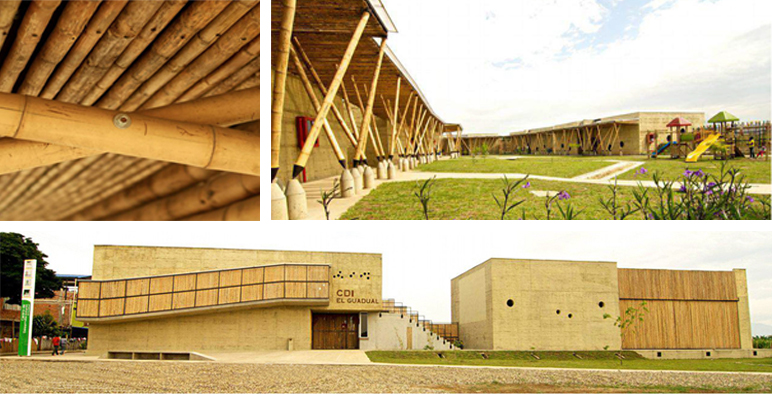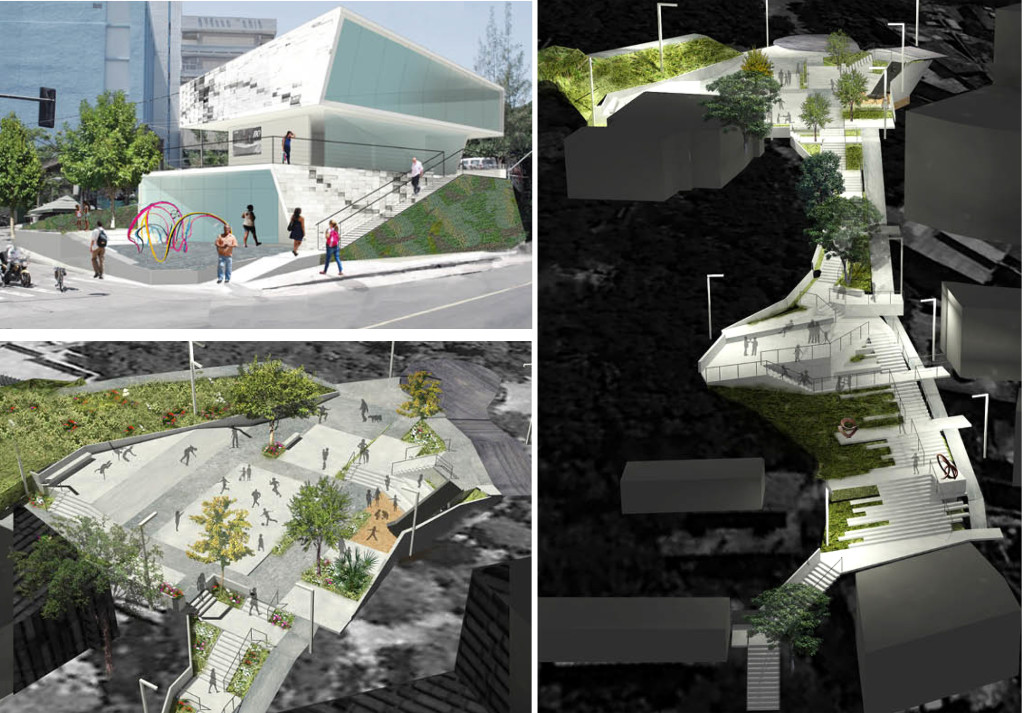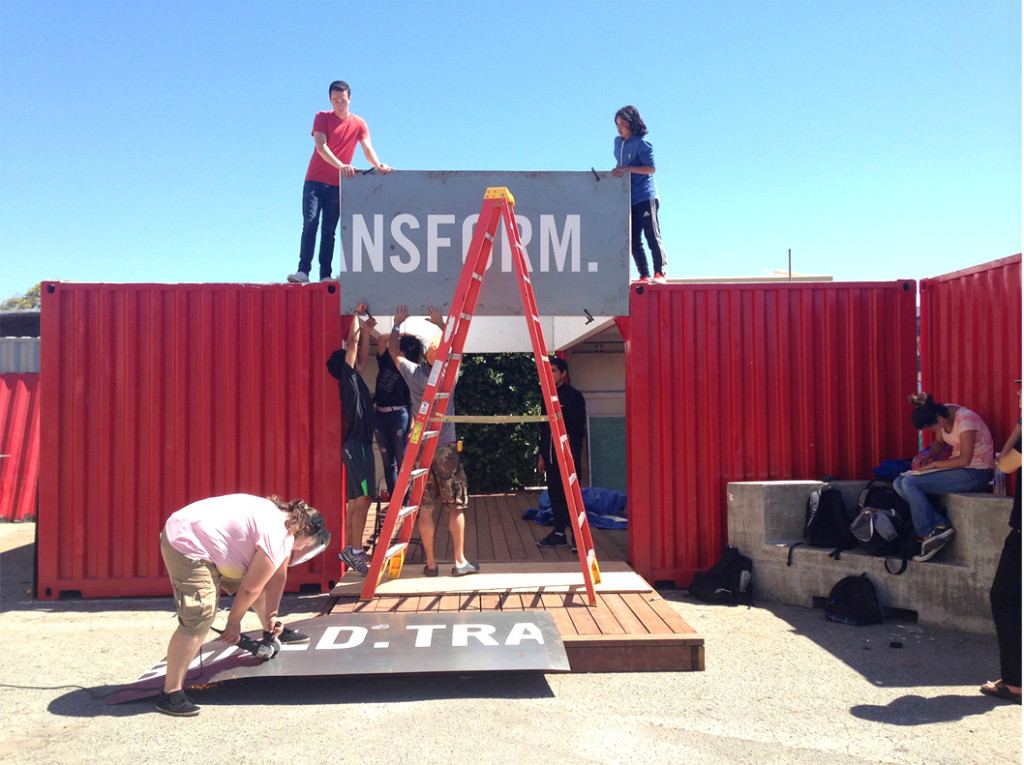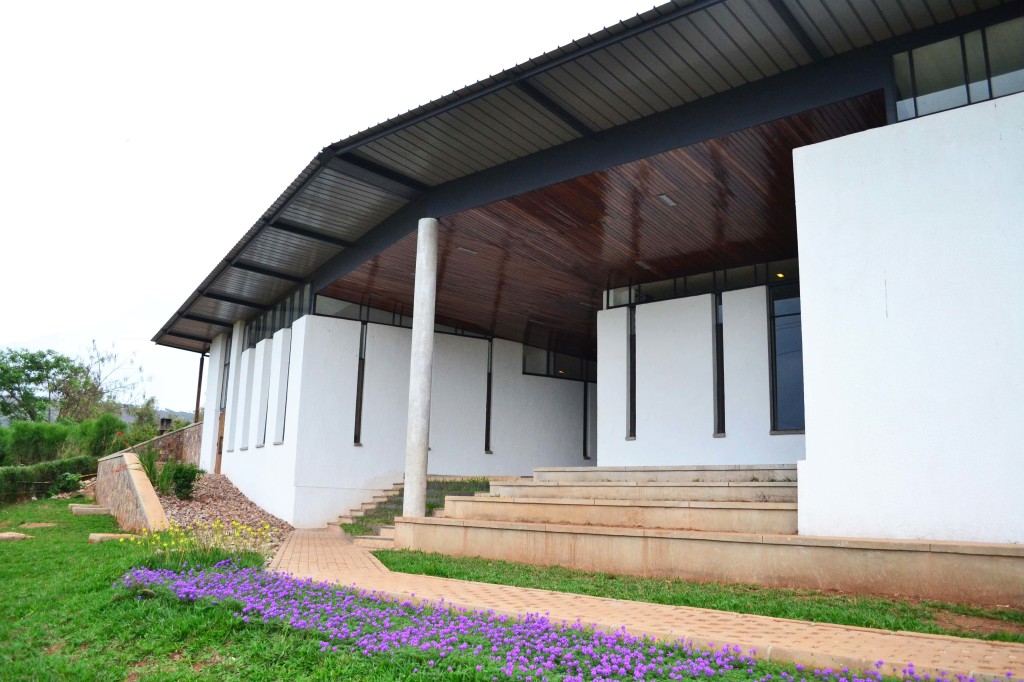2015 Award Winners
El Guadual Early Youth Development Center

Location: Villa Rica, Cauca, Colombia
Issues: Child Care, Education, Health, Strengthening Community, Environmental Sustainability
Summary: Mostly Afro-Columbians, the population of Villa Rica (about 14,000) has been stuck in the middle of the on-going 60-year-long conflict due to its location and surroundings. Its proximity to the ocean and the mountains facilitated illicit trade operations. Surrounded by vast areas of sugar cane plantations, Villa Rica has been an oasis within a contested territory where extreme poverty and lack of governmental presence set the platform necessary for illegality to emerge. The design of the center is based upon the idea of creating spaces that stimulate kids to become effective individuals through decision-making, therefore raising a generation capable of understanding the positive alternatives that the war offers. The Emilio Reggia pedagogical model promotes education through play. The project is an open system of interconnected rooms providing various physical challenges, therefore offering both mental and physical stimulation.
Team: Daniel Feldman; Ivan DArio Quinones; Sandra Pineda; Gabriel Cano; Andres Ortega; Eugenioi Ortiz; Alta Consejeria Presidencial Para Programas Especiales – Maria Cristina Trujillo; Inctituto Colombiano de Bienestar Familiar; Fundacion Plan – Maria Alejandra Montoya; Fundacion Comaprtir – Leonardo Sanchez; Villa Rica Town Hall
Jury Review: The is an inspiring project. The design is beautiful – sturdy, while including elements that foster play and interaction. Beautiful classrooms with very good engagement of local constructors.
_______________________________________________________________________________________________________
Lakota Nation Building at the Keya Wakpala Development

Location: Mission, South Dakota, USA
Issues: Empowerment, Cultural Heritage, Food Security/Hunger, Economic Development, Green Energy
Summary: The Rosebud Indian Reservation faces multiple, socio-economic issues including the loss of traditional homelands and culture as well as the degradation of the familial tribal structure and language. The poverty and unemployment rates in Todd County, where the bulk of the tribal members reside, are both over 40% making it one of the five poorest counties in the United States. It begins with a fundamental question about “Who is responsible for the way things are?” This means honoring thousands of years of tradition, while acknowledging more recent unexpected changes, but then moving forward with the realization “We must seek a new path if we are to reclaim and define the best parts of who we are if we are to thrive.” As an indigenous community, Keya Wakpala will provide housing, businesses, jobs, learning environments, clean water, energy, infrastructure, and a balanced economic life in a manner that supports, cultivates and re-emerges cultural values, and relationships. By re-integrating cultural meaning into our community, we place ourselves again in right relationship to culture and landscape.
Team: Rosebud Economic Development Corporation (REDCO); Wizipan Little Elk, Executive Director and Project Leader; Mindi Vavra, Finance Officer; Blue Star Studio Inc: Scott Moore y Medina, Project Architect; Jon Red Corn, Project Manager; David Jaber, Director of Performance & Audits; Travis Roubideaux, Designer; Barb Dills, Grant Writer; Jesse Benedick, Landscape Design & Graphics Associate; Sustainable Nations – Indigenous Systems and Community Empowerment: Dr. PennElys Droz, Executive Director; Chad Renfro Design: Chad Renfro, Interior Designer; Development Center for Appropriate Technology; David Eisenberg, Director; Biohabitats Inc: Erin English, Bioregional Team Leader and Senior Engineer; LeBeau Development LLC: Zoe LeBeau, President; Dream Design International Inc: Hani Shafai, President and Principal Engineer; Kyle Treloar, Project Engineer; Minnesota Housing Partnership: Chip Halbach, Executive Director; Rosemary Fagrelius, Housing Development Director; PAE Consulting Engineers: Conrad Brown, Principal Engineer; Ruwan Jayaweera, Project Engineer; Skyline Engineering LLC; S. Allen Freeland, Mechanical Engineer; University of Oklahoma School of Architecture – Division of Regional & City Planning: Dr. Dawn F. Jourdan, Director
Jury Review: Special Jury Commendation – This planning document is an incredible asset for the community, a clear and moving description of the community, their history and the challenges that they face. The project goals are completely aligned with SEED principles. The community surveys, meeting minutes, and other docs show an amazing amount of work. A profoundly moving statement here – “Times have been hard, but our people still remain” – that also describes other under-resourced (and underestimated) people that can learn from this.
_______________________________________________________________________________________________________
Parque Urbano e Instituto Sitie [Urban Park and Institute Site]

Location: Rio de Janeiro, RJ, Brasil
Issues: Transformation of Trash Dump into Public Green Space, Control of Disorganized Urban Growth in Informal Area, Entrepreneurship + Meritocracy, Control of Risk of Erosion and Landslides, Agro-forest [reforestation with urban agriculture]
Summary: Over 20 years, a total of 16 tons of garbage accumulated in Favela of Vidigal, Rio de Janeiro. Roughly 25,000 residents live in this informal area, and they came together and started removing the trash over the course of 6 years discovering that the most effective way to recuperate the land and prevent new housing invasions was to plant. With only 0.25 square meters of public space per habitant in an area of extremely steep terrain, the need for a space for leisure, culture, well-being, and participatory democracy was, and remains, an urgent necessity. A process of reforestation has started, including seedlings from the Botanical Garden of Rio, and started an area for urban agriculture, and including the construction of Rio’s first Digital Agora from recycled tires to create a new space for public debates and cultural activities, a space that also serves as a resilience infrastructure.
Team: Pedro Henrique de Cristo, Director; Caroline Shannon de Cristo, Curator; Mauro Petronilho Quintanilha, President; Paulo da Silva; Manoel Alves; Luis Silva; Paulo Cesar de Almeida; Manoel Alves; Paula Cesarino da Costa; Patricia Villela Marino; Marisa Moreira Salles; Caludia Moreira Salles; Tomas Alvim; Carlos Augusto Junqueira; Joshua David (Honorary Member); Community of Biroscao, Vidigal, Rio de Janeiro; +D/Design with Purpose Studio; Instituto PDR; Arq.Futuro; FGV-Direto Rio de Janeiro; CMS Design
Jury Review: This project works at scales of trash dump reclamation, control of landslides, community organization, and a found material system (tires) that can be replicated by others and has been shared with others in the region. The fact that the design team are deeply embedded in the community and investigating durable tools (like property rights, title, financing mechanisms) pushes this beyond just a nice community-built ecologically remediating park.
_______________________________________________________________________________________________________
A jam manufactory for NAXII

Location: San Jeronimo Tecoatl, Oaxaca, Mexico
Issues: Empowerment, Local Identity, Women, Economic Development, Environmental Sustainability
Summary: The social structure of the village San Jeronimo Tecoatl in the Mazateca Alta resembles that of a large family. The families live in a strong community and support each other in raising children and preparing meals. Agriculture, mainly the cultivation of coffee crops, vegetables and fruits, is the main income source, however, due to the rising import rate of food, paid work positions are getting lost resulting in residents migrating to the North in the search for paid work. As a result, the cooperative NAXII (`big piece of stone` in mazateco) was founded in 1999 as a base of empowerment and economic growth for local women. Over the years, local women gained the respect and acceptance in the village and the region, even in official community counsels. They managed to generate a new source of income by running a cybercafe and a food conservation manufactory in a small 2-story village house. Furthermore they are highly motivated to pass on their practical and theoretical knowledge through organized workshops. The building project itself created a common identity for the women in a rural context.
Team: CoCoon (sector for contextual construction): Ursula Hartig, Nina Pawlicki; Fachgebiet Landschaftsbau/Objektbau, Prof. Cordula Loidl-Reisch, TU Berlin: Simon Colwill; Fachgebiet Tragwerksentwurf und -konstruktion, Prof. Dr. Klaus Rueckert: Daniel Weinhold; Students: Philipp Mueller, Stella Goldmann, Karoline Fahl, David Eder, Philip Kempfer, Gabriel Spera, Kareen Feldhoff, Armin Schropp, Katharina Laekamp, Christian Neumann, Franziska Kreft, Jessica Schulze, Jan Roesler, Mara Schultze, Emmanuel Laux, Sofia Ceylan, Annika Falkstedt, Florian Zwangsleitner, Monica Lamela, Alberto Sanchez, Lucia Pasquali, Marbet Salazar Bernal, Maria Fernanda Gonzalez Polo, Andrea Olvera Villa, Sebastian Gnaedig Avila; Organizacion de Mujeres Unidas Naxii, Client; Graciela Garcia Reyes, President; CAMPO, Partner; Cesar Morales Rodriguez, President; UNAM students: Marbet Salazar Bernal, Maria Fernanda Gonzalez Polo, Andrea Olvera Villa, Sebastian Gnaedig Avila; Nils Dallmann, Architect; Ana Laura Felix, Architect; Hilfswerk der deutschen Lions, Funder; DAAD – German Academic Exchange Service, Private donors
Jury Review: A beautiful building and effective, respectful cross-continental collaboration between the women of NAXII and TU-Berlin to use a surplus local resource into an empowering economic product. Relationship between design students and local residents by having them hosted by families.
_______________________________________________________________________________________________________
Studio H Collaborative Research Project

Location: Berkeley, CA, USA
Issues: Empowerment, Education, Housing/Shelter, Entrepreneurship, Environmental Education
Summary: Studio H as an in-school course is a direct design response to the limited and standardized-test driven pedagogy of most public schools. By creating a design/build studio and workshop environment, Studio H teaches standards-aligned core subject content through projects that are not only full-scale and hands-on, but public and built for a specific community or client. This means that the quality and standards of both our process and product must remain high, holding students to a higher expectation of their own learning and character. For public education, a program like Studio H is a game-changer for school administration and families who have been alienated from real-world learning opportunities because of recent philosophical shifts towards more test-driven rote instruction. Also, Studio H is taught by experts who bring an architectural and enterprising knowledge to the classroom, asking students to go beyond the classroom walls to build as leaders for others.
Team: Emily Pilloton; Rebecca Beamer; Thomas Gardner; Hallie Chen; 80+ high school students in the program at REALM Charter School; 75 high school students from the Bertie County School District, NC; REALM Charter School; Opportunity Village; Autodesk; National Endowment for the Arts
Jury Review: Very robust and appropriate research agenda. Among the very good parts of the explanation is the attempt to reach, though a different approach, young people who have personal learning or disciplinary challenge who are allowed to and required to think differently and to re-engage academically through hands-on and community-focused architecture. Program appears to be effective means for the students to meet responsibilities and gain a sense of purpose. The evaluations use a good spectrum of measurement.
____________________________________________________________________________________________________________
Rwinkavu Operating Rooms and Neonatal Intensive Care Unit (OR / NICU)

Location: Kayonza District, Eastern Province, Rwanda
Issues: Health, Local Identity, Job Training
Summary: Over 40% of residents of Kayonza district are defined by the Rwandan government as living below the poverty line; just over 7% of households have access to electricity. Though literacy is quite high, the majority of families – just under 80% – rely on agriculture as their principal source of income, rendering any new employment and high-value skills training opportunities highly relevant. According to statistics by Partners in Health, under-five mortality in Kayonza district remains higher than in surrounding districts, bringing this improved neonatal care ward to the top of the list of priorities. The NICU and OR building’s design responds to both issues identified by the facility’s doctors, patients, and administrative staff who occupied the old NICU wing, as well as to the gaps in infrastructure identified by the Ministry of Health.MASS prioritized patient wellbeing, as the building replaces a small and hot room that constituted the previous NICU. This spacious facility, in one of the hottest regions of the country, was designed for cross-ventilation; a system of high and low windows facilitates natural cross-breezes. The carefully-landscaped spaces allow visitors to stay close at hand without overwhelming the NICU and OR’s medical and patient areas.
Team: Michael Murphy, Co-founder and CEO; Alan Ricks, Co-founder and COO; Christian Benimana, Project Manager; Garret Gantner, Project Manager; Amelie Ntigulirwa, Global Health Corps Design Fellow; Commode Dushimana, Project Designer; Partners in Health; Rwanda Ministry of Health
Jury Review: This is “Capital A” Architecture that meets a critical public health need. It is a beautiful building involving training of local builders in extending traditional construction methods into new configurations and potentials. A good example of an office putting their full energies and assets into a project.
_______________________________________________________________________________________________________
View 2014 SEED Award winners here.